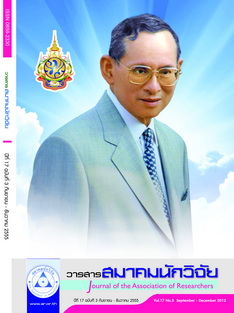CASUAL RELATIONSHIP MODEL TOWARD PROBLEMS ON INCOME TAXATION FROM MARRIED COUPLES IN THAILAND
Main Article Content
Abstract
The research was aimed at studying 1) personal income tax from married couples as taxpayers 2) a degree of problems on personal income tax from married couples and 3) casual relationship model toward problems on personal income tax from married couples in Thailand. This research was not only quality research synthesizing problems on personal income tax from married couples in Thailand but survey research surveying the sample group of married couples as taxpayers who summit the personal income tax return for taxpayers with income in General Cases (P.N.D.90) and the personal income tax return for taxpayers with income from Employment under Section 40 (1) of the Revenue Code only (P.N.D.91) to the Revenue Department. The statistics used for analysis was the Statistical Package Program. The research finding indicated that 1) personal income tax from married couples in Thailand at present was collected as the principle of equity for equality among all taxpayers. It was fixed by a real income of taxpayers – the more income they got, the more amount of taxes they paid. Also, this personal income tax was made as to the principle of convenience for solving the problem of repeated personal income tax by decreasing it to as little tax amount as possible and for changing the system emphasizing more flexibility in accordance with current economic change. 2) Problems on personal income tax from married couples finding indicated that the sample group of married couples as taxpayers experienced the problems of personal income tax from married couples at medium level and of as taxpayers and tax collectors at the medium level (X= 3.03) as well. 3) the generally personal information, which was education, income, work experience, a type of personal income tax and acknowledgment of the information about personal income tax via private, mass and identity media correlated with the problems on personal income tax from married couples in Thailand at the statistical significance of 0.05.
Moreover, the causal relationship model toward problems on personal income tax from married couples in Thailand was developed into a parsimonious model, which had the ability to predict at a good level and acceptable because the square multiple correlations was 0.695 or 69.5% which its acceptance was 40% up. Keywords: Personal Income Tax, Married couples
Article Details
บทความที่ปรากฏในวารสารนี้ เป็นความรับผิดชอบของผู้เขียน ซึ่งสมาคมนักวิจัยไม่จำเป็นต้องเห็นด้วยเสมอไป การนำเสนอผลงานวิจัยและบทความในวารสารนี้ไปเผยแพร่สามารถกระทำได้ โดยระบุแหล่งอ้างอิงจาก "วารสารสมาคมนักวิจัย"
References
คุรุสภาลาดพร้าว กรมสรรพากร. (2554). “ภารกิจและบทบาทของกรมสรรพากร” ใน รายงานประจําปี 2554 กรุงเทพฯ
กรมสรรพากร ชูใจ คูหารัตนไชย. (2542). สถิติเบื้องต้น (Introduction to statistics), กรุงเทพฯ: ภาควิชาสถิติประยุกต์ มหาวิทยาลัยเทคโนโลยีมหานคร,
นําชัย ศุภฤกษ์ชัยสกุล. (2550). โมเดลสมการโครงสร้างเชิงเส้น โดยใช้โปรแกรม Lisrel สําหรับข้อมูลภาคตัดขวาง (Cross-sectional Data) สถาบันวิจัยพฤติกรรมศาสตร์มหาวิทยาลัยศรีนครินทรวิโรฒ ประสานมิตร กรุงเทพฯ
พัทธยา ยงชัยตระกูล. (2552). ปัจจัยเชิงสาเหตุและผลต่อความร่วมมือในการชําระภาษีอากรกับกรมสรรพากรของผู้ประกอบกิจการร้านค้าในแหล่งชุมชน กรุงเทพมหานคร. กรุงเทพฯ: รายงานการวิจัย ประจําคณะบริหารธุรกิจ มหาวิทยาลัยเทคโนโลยีราชมงคลพระนคร
วิมล สุธีร์วรพงศ์ (2546). ปัญหาในการจัดเก็บภาษีเงินได้บุคคลธรรมดาจากสามีภริยา. วิทยานิพนธ์ นิติศาสตร มหาบัณฑิต มหาวิทยาลัยธรรมศาสตร์
ยุวดี ศรีสัตยาชน. (2542). การกําหนดผู้มีหน้าที่เสียภาษีอากรตามประมวลรัษฎากร: กรณีศึกษา การเสียภาษีเงินได้ของคู่สมรสที่มิได้ร่วมกันประกอบธุรกิจ. กรุงเทพฯ: วิทยานิพนธ์ ปริญญานิติศาสตรมหาบัณฑิต บัณฑิตวิทยาลัย จุฬาลงกรณ์มหาวิทยาลัย
ลักษมี ทนะพงศ์. (2547). นโยบายการคืนภาษีเงินได้บุคคลธรรมดา. กรุงเทพฯ: วิทยานิพนธ์ ปริญญาศิลปศาสตรมหาบัณฑิต บัณฑิตวิทยาลัย มหาวิทยาลัยรามคําแหง,
เจมีการเล่น ศุภชัย บํารุงศรี. (2553). ความไม่เป็นธรรมในการจัดเก็บภาษีเงินได้บุคคลธรรมดา. กรุงเทพฯ : วิทยานิพนธ์นิติศาสตรมหาบัณฑิต บัณฑิตวิทยาลัย มหาวิทยาลัยรามคําแหง
Cronbach, L. J. (2003). Essential of psychological testing. New York: Hanpercollishes. Goldstein, J. W. (2003). Adding missing-data-relevant variables to FIML-based structural equation models. Structural Equation Modeling, 10(1), 80-100.
Heck, R. H. & Thomas, S. L. (2000). An introduction to multilevel modeling techniques. Mahwah, New Jersey: Lawrence Erlbaum Associates. Morris, C. N. (1995). Hierarchical models for educational data: An overview. Journal of
Educational and Behavioral Statistics, 20(2), 190-200.
Saris. W. E. & Strenkhorst. L. H. (1984). Causal modeling non-experimental research: An Introduction to the lisrel approach. Dissertation Abstract International. 47(7), 2261-A.
Yamanae. (1973). Statistic: An introductory analysis. (30 ed.) New York: Harper & Row.
Wong, G. V. & Mason, W. M. (1985). The hierarchical logistic regression model for multilevel analysis. Journal of the American Statistical Association, 80(391), 513-524.


